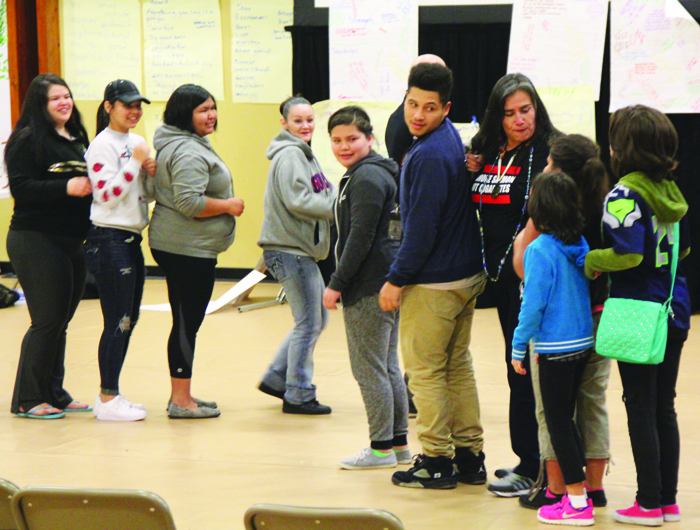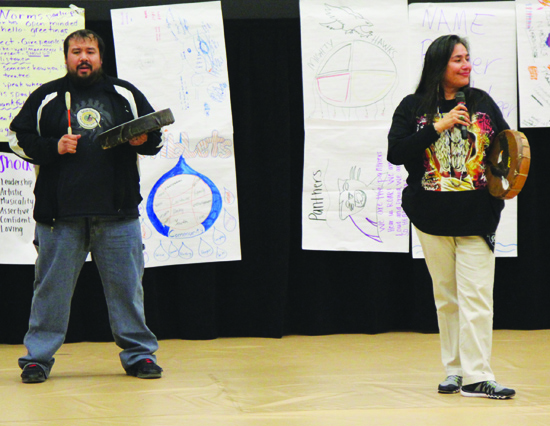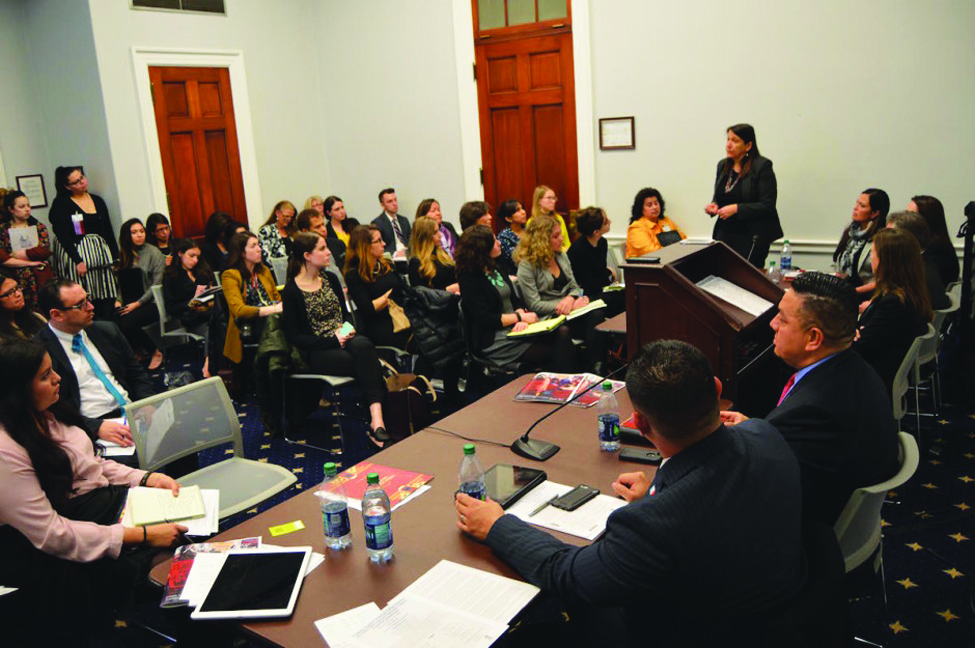Month: March 2016
Cultural teachings continue with new story poles at Tulalip
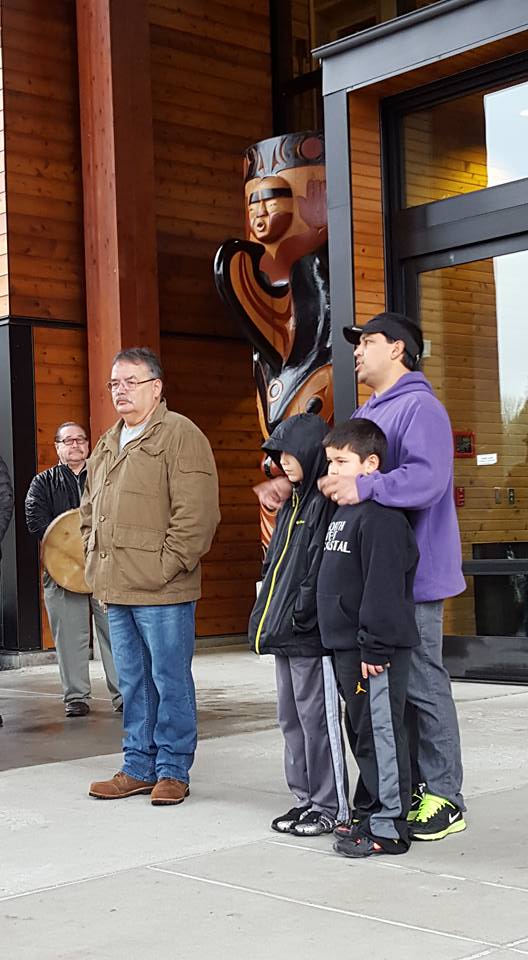
By Kim Kalliber, Tulalip News
“We’re not petrified, we’re still alive”
These strong words by James Madison were spoken by his grandfather, Frank Madison, before him. And that is the message Madison wishes to convey to the next generation of Native youth, keep us alive.
Maintaining our culture is of the upmost importance to Indigenous communities like Tulalip. On March 7, Tulalip tribal leaders, tribal members and tribal employees gathered outside the Tulalip Administration Building to welcome two beautiful new story poles, one featuring an orca, the other an octpous, that take position outside the entrance to the building. The poles, made from red cedar, were created by Tulalip master carvers, Joe Gobin and James Madison.
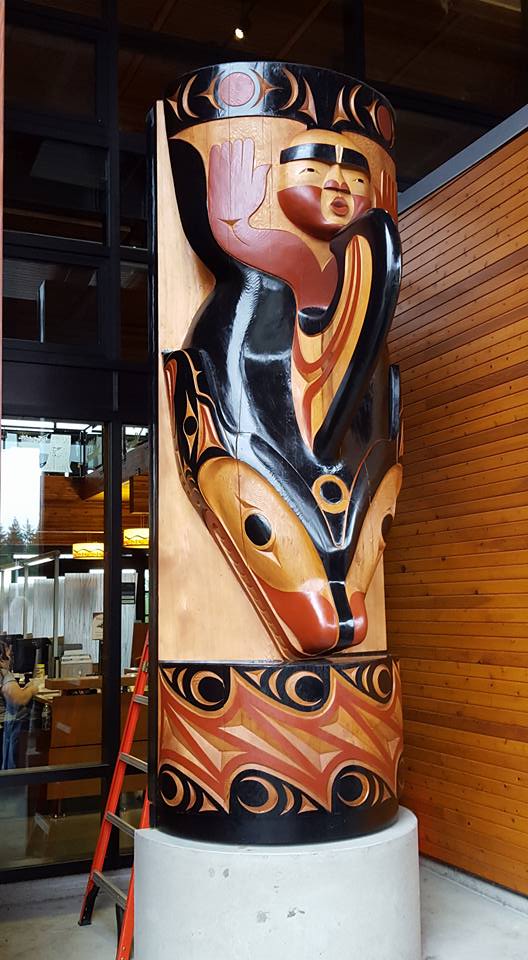
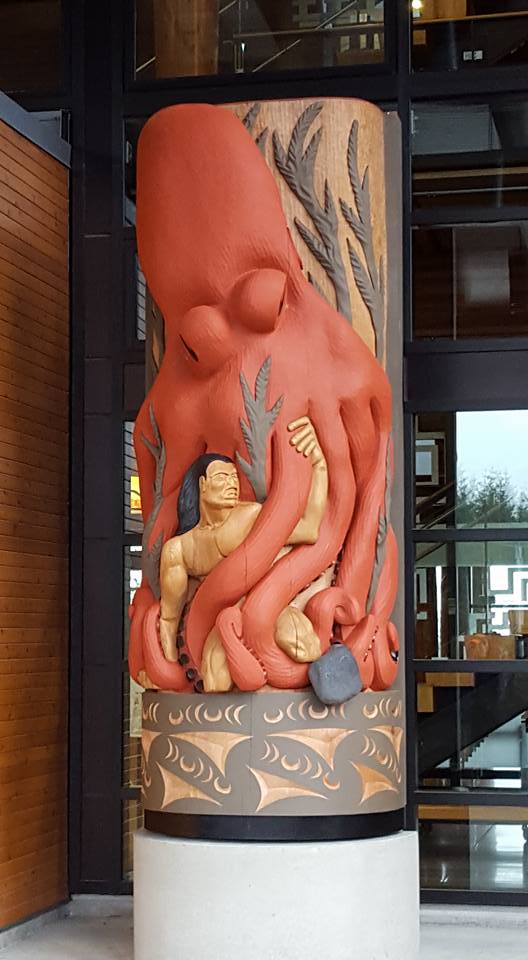
The unveiling of the poles began with a prayer followed by singing and drumming. Gobin and Madison then shared the meaning of the poles.
Gobin, who carved the Orca pole, explains that, “we’re killer whale people. The person on top is our spirit of the whale.” The eagle design represents the eagles that watch over our gatherings.
The octopus pole features a diving rock. This represents the power of the Native people. Madison’s grandfather told stories of this water power, and how they would jump into the water with a diving rock and get water power for protection.
Madison, with a hand on the shoulder of each his two sons, spoke of how proud his grandfather is for us putting our culture into our tribal buildings.
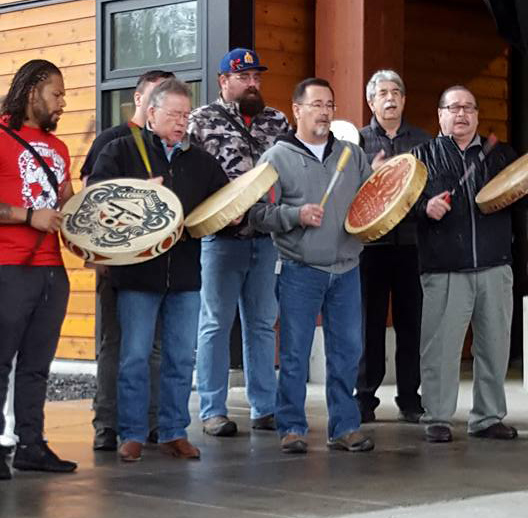
Tulalip Tribal Chairman Mel Sheldon and various tribal board members gave thanks to the artists and the art work, while emphasizing the importance of the teachings being passed on.
Wrapping up the unveiling was a singing and drumming performance by Quil Ceda Elementary students.
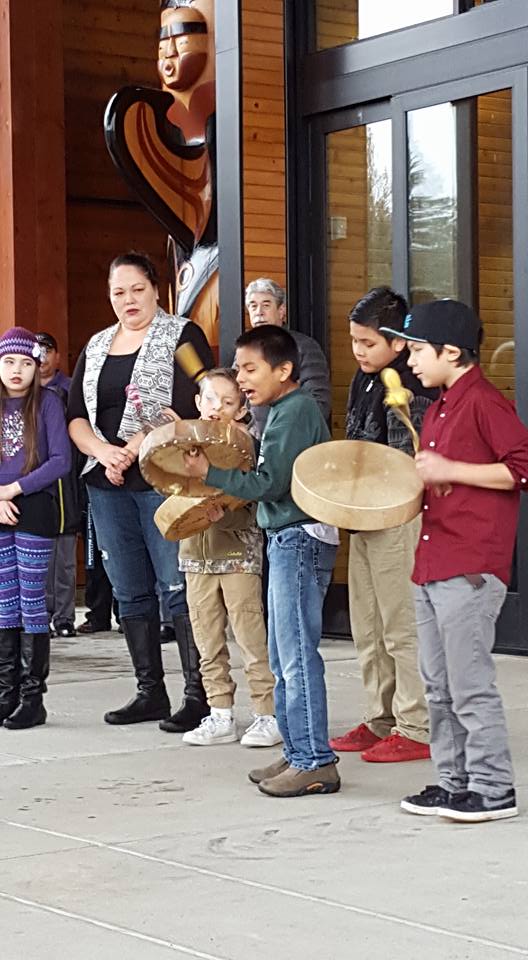
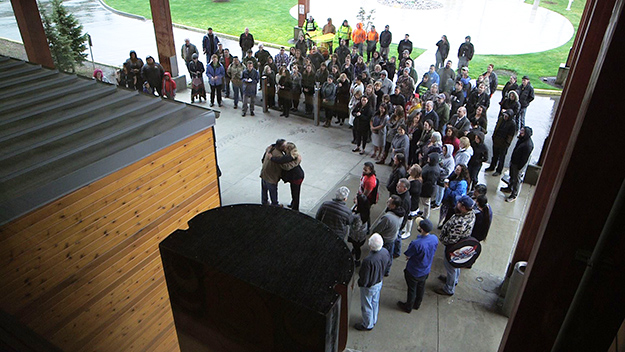
March 9 2016 syəcəb
Stand together, build together Your Voice. Your community.
By Micheal Rios, Tulalip News
February 25-27, the Tulalip Tribes hosted their very own Gathering of Native Americans (GONA) at the Don Hatch Youth Center. Our three-day GONA was an event inspired to bring our community together to work on creating a vision for a healthy community.
Tulalip was fortunate to be nominated as one of the eight tribes in the United States by the Indian Health Service to serve as a Community Partnership grantee. As a grantee, Tulalip received the materials and resources necessary to undergo an intense community training and technical assistance that became our GONA.
GONA is for Native Americans and others who want to become change agents, community developers, and leaders. The four parts of GONA (Belonging, Mastery, Interdependence, and Generosity) incorporate the values of four levels of human growth and responsibility that are found in Native cultures.
Based on several ideas:
- Community healing is necessary for substance abuse prevention;
- Healthy traditions in our community are key to effective prevention;
- The holistic approach to wellness is a traditional part of our belief systems;
- Every community member is of value in empowering the community; and
- GONA is a safe place to share, heal, and plan for action.
The three-day event focused on increasing the strengths of Native youth and community, healing the past and building the future. Over the last few years, countless GONAs have been held all over North America. Thousands of Native people from hundreds of tribes with their friends, families, and communities have experienced the powerful, culturally-centered training and resources GONA offers.
Through the four components of Belonging, Mastery, Interdependence, and Generosity we start to examine how to be an active participant in our own life and in creating a healthy community.
Belonging. Day 1 of Tulalip’s GONA started off by building and strengthening the sense of team, family and community. A place for all ages, a place for all kinds of people. The first day represents infancy and childhood, a time when we need to know how we belong. It is the most important first lesson a person must learn to live comfortable and to work effectively.
Mastery. After dinner, day 1 moved to the component of gaining mastery and healing from what holds us back. Empowerment, for the individual and community. This second stage honors adolescence as a time of vision and mastery. Understanding our Tulalip communities and the local contexts that inform work in partnership with other tribes/communities/governments.
Interdependence. Day 2 was dedicated to working together interdependently for positive change. A day of action and community leadership. The third stage is symbolized by adults, integral and interdepending within their families and communities. How do we interconnect with our environment and social network of our community?
Generosity. Day 3, the final day of our GONA was all about giving back to self and community. The final stage honors our elders, who give their knowledge and teaching to our generations of the future. Looking at our responsibilities to give back to our communities and share graciously.
During each day, GONA attendees participated in various team breakout activities, heard and told stories integral to our culture, and helped to create individual affirmations and community goals.
Storytelling is traditional for Native peoples. Oral histories and legends were used to transmit knowledge, teachings, and values from one generation to the next. During GONA, storytelling was used to convey the same teachings as we heard, valued, and respected everyone’s contributions while establishing a foundation for a community-wide prevention plan.
The group and team activities were all exercises that demonstrated the core components and helped participants identify some of the rituals or ceremonies from Tulalip culture that have helped our community to remain healthy and in balance. The activities also provided everyone with the opportunity to embrace wellness while recognizing the importance of traditional healing practices.
Contact Micheal Rios: mrios@tulaliptribes-nsn.gov
Standing Room Only at Congressional Briefing on the Impact of VAWA 2013 in Indian Country
February 24, 2016, Press Release: National Indigenous Women’s Resource Center, www.NIWRC.org
Washington, D.C. — More than 100 people accepted the invitation to attend a congressional briefing, Violence Against Women and Implementation of VAWA 2013 Special Domestic Violence Criminal Jurisdiction held February 23, 2016 in Washington, D.C.
“VAWA was a major step but it was just the beginning to restoring to Indian tribes – sovereign nations – the authority to protect women,” said Congressman Xavier Becerra. “I want to thank those tribes who are implementing tribal jurisdiction over non-Indians committing domestic violence on tribal lands because we can now talk about real successes. Now we have cases of Native women who have had their rights defended.”
The 2013 Violence Against Women Act affirmed tribes’ ability to exercise special domestic violence criminal jurisdiction (SDVCJ) over non-Indian defendants within Indian country for domestic or dating violence against Native women, and violations of protection orders. The briefing provided updates on tribal implementation of this life-saving legislation.
“Why was this provision needed?” asked Terri Henry, the moderator of the briefing and the former chairwoman of the Eastern Band of Cherokee Indians and current Co-Chair of the National Congress of American Indians Task Force on Violence Against Women. “Because the rates of violence perpetrated against Native women showed that 6 in 10 Native women will be victims of domestic violence. And 1 of 3 Native women will be raped in their lifetime, many of which are domestic violence related.”
The briefing was cosponsored by the National Indigenous Women’s Resource Center (NIWRC), the Indian Law Resource Center (ILRC), and the National Congress of American Indians (NCAI). The honorary congressional co-hosts were U.S. Representatives Louise M. Slaughter, Betty McCollum, Gwen Moore, and Xavier Becerra.
“But, when you look at national statistics for Native women, what is lost in translation is the complexity of the criminal justice system and understanding that these crimes are perpetrated at the local level. In the case of Native women, these crimes are committed at the local, tribal level,” shared Ms. Henry. “Our reality is that our tribal lands have become safe havens for perpetrators.”
As of January 1, 2016, eight tribes have implemented special domestic violence criminal jurisdiction over non-Indians under VAWA 2013. Together, the tribes have made 44 SDVCJ arrests, resulting in 18 guilty pleas, 5 referrals for federal prosecution, 1 acquittal by jury, 12 dismissals, with 6 cases pending.
The Pascua Yaqui Tribe began exercising SDVCJ on February 20, 2014, as part of the DOJ Pilot Project. “We knew these offenses were occurring for many years and all we could do was drive the abuser to the edge of the reservation. We found that the non-Indian defendants had a long history of violence and were repeat offenders, some with criminal convictions and outstanding felony warrants,” said Alfred Urbina, Attorney General, Pascua Yaqui Tribe.
Since implementing SDVCJ, the tribe has made 26 SDVCJ arrests involving 20 separate offenders, resulting in 6 guilty pleas, 4 referrals for federal prosecution, 1 acquittal by jury, and 10 dismissals. Pascua Yaqui reports that since it began implementing SDVCJ, cases involving non-Indians have made up 25% of the tribe’s domestic violence caseload.
“The 16 offenders investigated in the initial year accounted for 86 contacts with just Pascua Yaqui law enforcement before and after passage of VAWA 2013 and not counting state contacts. The offenders included African American, Asian, Hispanic and Caucasian men and one woman,” said Oscar “OJ” Flores, Chief Prosecutor of the Pascua Yaqui Tribe.
The Tulalip Tribes began exercising SDVCJ on February 20, 2014, as part of the DOJ Pilot Project. As of February 1, 2016, the Tribes had 11 SDVCJ arrests involving 9 defendants, resulting in 6 guilty pleas, 1 federal guilty plea, 2 dismissals, and 2 cases pending. The defendants have had a combined number of 109 contacts with Tulalip Tribal Law Enforcement since 2008.
“Non-Indian offenders had the feeling they could do what they wanted to because there was no way they would be prosecuted. We could call county law enforcement but their response was very long or they would not come at all,” said Glen Gobin, Vice Chairman of the Tulalip Indian Tribes. “Now the tribe can prosecute non-Indian offenders but the jurisdiction is limited to certain crimes, it does not protect victims of stranger rape, and does not protect children or other family members.
“I am here to ask for your help to protect our children. The law today does not allow our tribe to charge crimes by non-Indians against children who are present or involved. We need the jurisdiction to protect our children,” said Theresa Sheldon, Councilwoman, Tulalip Tribes.
In response to a question asking what members of Congress can do to help in the coming weeks, Virginia Davis of the National Congress of American Indians responded, “The most critical support needed right now is tied to resources for Indian tribes to enhance their response and implement this life-saving provision. Most significant is tribal access to the Crime Victim’s Fund which is the main source of federal funding to crime victims. These funds do not currently reach Indian country well because there is no dedicated funding stream for Indian tribes. This could be fixed in the appropriations process. Last year the Senate included money from the Crime Victim’s Fund in the CJS bill but the House did not. In the ultimate bill that was passed it was not included. We are hoping for your support over the coming months.”
“I want to thank all of you implementing the hard fought legislation won under the Violence Against Women Act. You have learned from your cases prosecuting non-Indians. We knew that VAWA needed to protect all women,” said Congresswoman Gwen Moore. “We need to expand the jurisdiction over children, sexual assault and other crimes connected to domestic violence. Tribal women certainly should have the protection of their law enforcement and know they can live safe in their community.”
NARCAN Education and Training, March 15
Please come and join Tulalip Family Services/Behavioral Health for an evening of education and training on March 15, 5:30-7:00 p.m. at the Tulalip Tribes Administration Building. The training will address overdose and use of Naloxone (Narcan) as an overdose responder. Tribal members who attend the training will receive an overdose responder kit upon request.
Lady Hawks vs. Hurricanes and Owls, move on to State
Lady Hawks lose first game of the year, finish 2nd at Tri-District

Photo/Micheal Rios
By Micheal Rios, Tulalip News
On Saturday, February 20, the undefeated (22-0) Tulalip Heritage Lady Hawks played in the Tri-District championship game hosted at Lummi Nation high school. Their opponent was the Mt. Vernon Christian Hurricanes.
These two teams met just two weeks prior in the District 1B tournament. In that game the Lady Hawks trailed for the better part of three quarters before taking the lead in the 4th quarter. That lead quickly disappeared and it took an Aliya Jones bucket in the final 50 seconds to secure the victory. That was the closest the Lady Hawks had come to losing all season.
On to the Tri-District championship game. It played out very much the same as their first meeting, with the Hurricanes jumping out to a big lead early and the Lady Hawks having to play catchup.
What we’ve seen from the Lady Hawks all season is they play a 2-3 defense that really causes problems for the majority of teams out there. However, for those few teams who have really good shooters and players not afraid to shoot from 3-point territory, that 2-3 zone is much less a problem. The Hurricanes are such a team. They came out launching from deep and were connecting at an impressive clip. The Lady Hawks found themselves trailing 2-13 only minutes into the game. At the end of the 1st quarter they trailed 8-16 and at halftime they trailed 17-22.
At halftime the Lady Hawks would turn the reigns over to their star player Adiya Jones. If they were going to mount a comeback it would be on the back of her offensive skills. And that’s what played out, almost.
Adiya went on a scoring spree that spanned the 2nd and 3rd quarters in which she converted 10 buckets on 11 shots. Midway through the 3rd quarter she had scored 24 points and assisted on two Cyena Fryberg buckets to give the Lady Hawks a 31-25 lead. The Hurricanes refused to go away though and finished the 3rd quarter on a 6-0 run, leaving the game tied 31-31 with only the 4th quarter left to play.
In the 4th quarter, the Lady Hawks took a 37-34 lead with just over 5:00 left to play. Unfortunately, the offense would only be able to muster a single bucket in the final five minutes against the Hurricanes defense. The Hurricanes refused to let Adiya single handedly beat them, as they adjusted their defense to double-teaming her off the ball. This defensive strategy worked because on this day no Lady Hawk outside of Adiya was able to find an offensive rhythm.
The Lady Hawks fell to the Hurricanes with their impressive outside shooting, 39-41, and finished 2nd in the Tri-District Tournament. It marked the first loss of the season for the Tulalip girls.
Adiya led all scorers with 28 points on 12-20 shooting. All other Lady Hawks combined to score a season low 11 points on 5-30 shooting.
Lady Hawks bounce back with 54-42 victory at Regionals. On to State

Photo/Micheal Rios
After suffering their first loss of the season in the Tri-District championship game, the Tulalip Heritage Lady Hawks (22-1) got a week of rest and preparation for their state qualifying game on Saturday, February 27. Their opponent was the Mary M. Knight Owls out of Elma, Washington. The game was played at the Everett Community College gymnasium.
On the line was a berth to the 1B State playoffs held in Spokane. Win and be one of only eight teams to play for the State Championship, lose and the season is over.
Similar to their last game, the Lady Hawks opponent came out firing from 3-point territory. The Owls connected on four 3-point shots early in the 1st quarter to take 12-7 lead. Coach Bubba Fryberg called a timeout to make sure his team understood that defensively all the perimeter players had to be quick to contest the Owl shooters. They had to contest those shots and not give them clean looks from outside.
Following the timeout, the Lady Hawks locked in defensively and used that tenacity to score at will on the offensive end. Spanning the 1st and 2nd quarters the Lady Hawks went on a very impressive 20-0 run to take a 27-12 lead. At halftime Tulalip led 29-19.
In the 2nd half, the Lady Hawks would continue to play top notch defense and allow Adiya to run the offense as a point-forward. The Owls has no answer for Adiya. Even when they would double and triple team her, she was just too big and too strong for the smaller Owl players. The Lady Hawks had no difficulty finishing the game and won 54-42.
Adiya once against stuffed the box score and led her team with 26 points, 17 rebounds, 6 assists, 5 steals, and 3 blocks. Aliya and Keryn both scored 9 points apiece, while Cyena and Desirae combined to chip in 10 points.
Next up for the Lady Hawks is the 1B State playoffs where they will be one of eight teams vying for the coveted State Championship.
Heritage boys basketball comes to an end
By Micheal Rios, Tulalip News
On Saturday, February 20 the Heritage Hawks (15-11) traveled to Lummi Nation to take on our biggest rivals, the Lummi Blackhawks (16-8). The two teams were playing in the 5th place game of the Tri-District Tournament. Win and the season continues with a game at Regionals and a chance to continue to State, lose and the season is over.
The Hawks took two of three regular season games over Lummi with an identical score of 51-43 in both those wins. However, in that last matchup Lummi made some adjustments to their game plan and it payed off as they won big 78-54 over the Hawks.
In the 1st quarter, the Hawks were outscored 12-21. In the 2nd quarter, the Hawks would cut their deficit to only 4 points, but a Lummi run to close the half pushed the deficit to double digits. At halftime the Hawks trailed 22-33.
During the regular season, the Hawks defense had been able to contain the Blackhawks best player, Trazil Lane, through very good zone defense and a series of timely presses. But on this day Trazil wasn’t going to be denied as he set the tone in the 1st half with a couple dunks on his way to leading the game in scoring.
For the Hawks, their leaders Willy Enick and Robert Miles, did everything they could in the 2nd half to try to give their team the lead. They managed to cut the deficit to only 5 points, but every time they’d shrink that deficit Lummi would respond with an offensive run.
In the end, Lummi was just the better team on this day as Trazil Lane’s game high 31 points overshadowed Robert’s 20 points and Willy’s 14 points. The Hawks lost the game 54-66, ending their season.
The Hawks, with a final (15-12) record on the season, had a successful season overall. Losing four of five senior starts from last year meant many new faces this year who had little organized basketball experience. Leaning on the talents of current seniors Robert and Willy, the Hawks managed to finish 2nd in their league and placed 3rd at the District Tournament.
The sweetest win of the season came in the Tri-District Tournament when the Hawks defeated the Orcas Christian Saints, who had swept the Hawks 3-0 during the regular season, in a come from behind nail biter.
Just like last year, the Hawks will be graduating several players this spring. Dom Joseph, Robert Miles, Willy Enick, Terrence Phillips, Bobby Jeter, and Nate Williams are all seniors planning to graduate this spring.
Contact Micheal Rios, mrios@tulaliptribes-nsn.gov
Patricia Marie Morris
Patricia Marie Morris born February 8, 1952, passed away on February 25, 2016.
A visitation will be held on March 1, 2016, at The House of Awakened Culture in Suquamish, WA at 6 p.m. with services on March 2, 2016, at 11 a.m. Burial to follow at Suquamish Cemetery.







